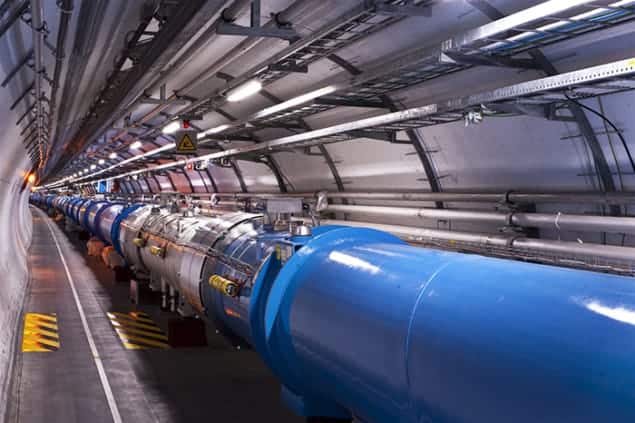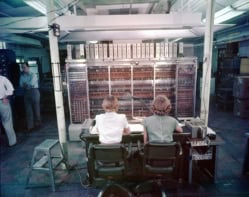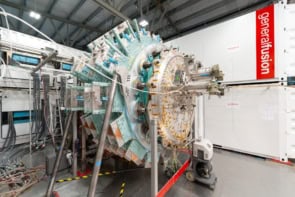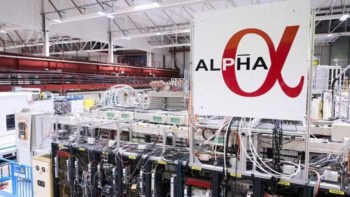
After a two-year hiatus, CERN is set to restart the Large Hadron Collider (LHC) and its main experiments ALICE, ATLAS, CMS and LHCb over the next few weeks. After discovering the Higgs boson in 2012, the LHC was shut down in February 2013 for a major upgrade of the accelerator and its experiments. If all goes well, the LHC and its experiments will be fully operational and collecting data in late May or early June 2015.
Upgrade work – including a complete overhaul of the superconducting connections between magnets – was completed last June, and much of the LHC has now been cooled to its operating temperature of 1.9 K. On 7 March, the first proton beams were transported through some sectors of the 27 km-long collider. By May of this year, the revamped LHC is expected to be colliding protons at a collision energy of 13 TeV, heralding the beginning of what CERN has dubbed “Run 2”. While this energy is nearly double that of the previous 8 TeV run, it is below the LHC’s design energy of 14 TeV. The decision to run at 13 TeV was made because of the extra time that is required to “train” the LHC’s superconducting magnets for 14 TeV collisions.
The higher energy should allow CERN physicists to improve their understanding of the newly found Higgs boson, because the number of particles produced in collisions is expected to increase by a factor of 10. Overall, physicists will have to sift through nearly five times more data in Run 2 than were produced in the LHC’s first run. CMS spokesperson Tiziano Camporesi, says that they will not be using “brute force methods” to cope with this deluge of data, but have instead developed more efficient ways of processing it.
Another important goal of Run 2 is the search for evidence of physics beyond that described by the Standard Model of particle physics. In particular, physicists will be looking for evidence of supersymmetry (SUSY) – a theory that predicts that every fundamental particle has a so-far-undiscovered “superpartner” particle whose properties are imperceptibly different. Other signs of new physics that could be detected include evidence for extra dimensions, exotic particles and dark matter.
No theoretical beacon
Looking for these phenomena will be very different from the search for the Standard Model Higgs, says Camporesi. During the hunt for the Higgs, physicists had a “theoretical beacon guiding us” towards the particle, he says. Beyond the Standard Model, he points out that “theory is at a loss as there are too many competing hypotheses, and so in a way the experimentalists are taking over”.
I want to see the first light in the dark universe. If that happens, then nature is kind to me
Rolf Heuer, director-general of CERN
Ironically, the LHC researchers will begin this process by testing extremely precise predictions made by the Standard Model. “We know what should happen at 13 TeV, so we will look everywhere for any deviations from what is predicted,” explains Camporesi. While certain theories such as SUSY are appealing because they do make precise predictions, it is not clear if and when the LHC will be able to confirm or rule out these theories. “The parameter space of SUSY is such that we may find it in the first week [of Run 2] or in 2035,” he explains. Indeed, Camporesi points out that even if finding SUSY lies beyond the abilities of the LHC, the collider may be well equipped to make precise predictions in much the same way as its predecessor at CERN, the Large Electron–Positron Collider, helped physicists to make an accurate prediction of the mass of the top quark.
Both the CMS and ATLAS experiments will be revisiting some of the fluctuations or oddities in the data that both detectors saw in Run 1. While most of these are expected to be statistical fluctuations from the Standard Model, if they grow in statistical significance throughout Run 2 it could indicate the emergence of new physics. Indeed, ATLAS spokesperson David Charlton says that previously dismissed candidates such as B quarks may be the very particles that “break the Standard Model”.
Missing energy
The situation is different for physicists looking for hints of dark matter in Run 2, because if the elusive particles are produced at the LHC they are not expected to be detected directly. Instead, physicists will be looking for missing energy in particle collisions, energy that has been taken away undetected by dark matter. Indeed, the LHC is back as a leading contender in the race between a number of diverse experiments to see further evidence of dark matter.
Maria Chamizo-Llatas, who was the CMS run co-ordinator on Run 1, says that there is plenty of engagement and discussion between CERN physicists and astrophysicists trying to detect dark matter in astronomical sources. She says that this co-operation is fruitful and necessary, and must increase so that the two communities can guide each other in their respective searches. However, she does confess that she would prefer it if CERN were to “see it first”. Indeed, Rolf Heuer, director-general of CERN, said at the CERN press conference held yesterday for the LHC restart, “I want to see the first light in the dark universe. If that happens, then nature is kind to me.”



